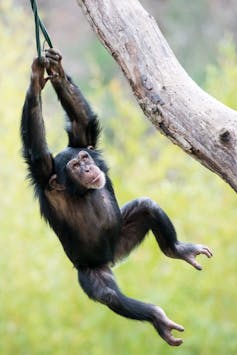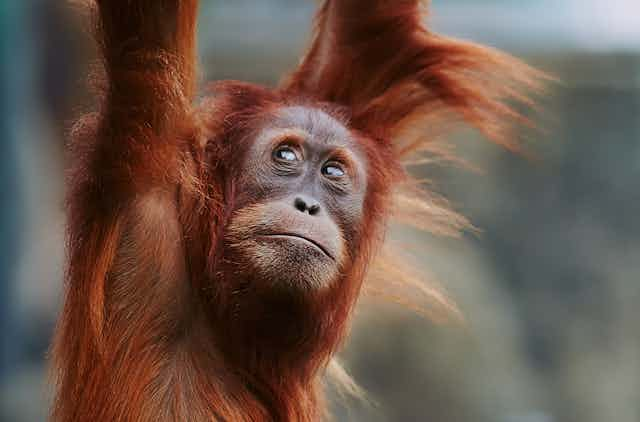Children love to spin. Whether it is by whirling around on their feet, whipping around on a tyre swing, or tumbling down a grassy hill, they revel in the drunken effects of dizziness that follow. As humans mature, they might outgrow spinning on the playground, but find other ways to alter their senses - dancing, skating, roller coasters, and for some of them, psychoactive drugs.
It turns out humans are not the only primate with a desire to spin ourselves and stimulate our senses. In a recent study, my co-author Adriano Lameira and I found some other primates like to do this too. The great apes – which include chimpanzees, bonobos, gorillas, and orangutans, in addition to humans – have a more complex brain than other primates and share a similar neurophysiology. Our findings suggest that they also share our desire to induce altered states of perception. This may even have played a role in the evolution of the human mind.
In 2011, and then again in 2016, a captive gorilla named Zola went viral for his flair for “breakdancing” – the spinning, playful displays that he liked to perform while splashing around in water. These videos made me wonder about the spinning behaviour of apes more generally.
Spinning has been documented as a part of great apes’ repertoire of communicative gestures, in previous research. But Zola’s behaviour appeared to be as much about fun as it was about communication.
I scoured YouTube for videos of spinning primates and found hundreds of examples of great apes and other primates spinning themselves around in different ways, from pirouettes to backflips.

In our study, my team focused on 40 videos which showed great apes spinning themselves on ropes and vines. We thought ropes might enable the apes to spin at faster speeds and for more rotations than they could with just their bodies.
Our intuition proved right: they often reached and sometimes exceeded speeds of two to three rotations per second. That’s as fast as human spinning experts we compared, which included ballet dancers, circus performers, Ukrainian hopak dancers and Sufi whirling dervishes.
Apes still get dizzy
These professionals train themselves to be immune to the sensory effects of extreme spinning. But – as I can attest, having recently tried this in my office (for science) – spinning around at even one rotation per second will make most people dizzy.
The spinning apes in our study appeared to fare no differently. They would often spin for multiple bouts. Three on average, with each bout lasting for about five-and-a-half rotations. Between bouts, the apes would sometimes let go of the rope and stumble around, often falling clumsily to the ground, before jumping back up to do it again.
Many of the apes we observed were in captivity, and in these cases, rope spinning may have helped them overcome boredom. But we also found several instances of young mountain gorillas in the wild spinning on jungle vines during playful social interactions, sometimes even taking turns. They too would spin, stumble around, fall, and get back up to do it again.
Given the close evolutionary relationship between great apes and humans, it is likely the motivation to spin stems from a shared tendency to seek and delight in experiences that stimulate and alter our senses.
Humans turn to drugs
Of course, humans sometimes go far beyond spinning to achieve this. The deliberate use of psychotropic drugs, from alcohol and tobacco, to marijuana and LSD, is widespread in cultures across the world.
It often plays an important role in many social rituals and spiritual ceremonies. For example, in some indigenous cultures of South America, the use of the ayahuasca (a hallucinogenic brew made from local plants) is used by shamans (and others) to connect with ancestors thought to exist in other realms.
Evidence of similar rituals can be traced back for millennia. Some scientists have argued that psychedelics might have been crucial to the evolution of modern human cognition and culture, enhancing our creativity and helping us to forge deeper social connections.
Mushrooms containing psilocybin might have played an especially important role, as they would have been prevalent in many of the habitats of our hominid ancestors.

Compared to twirling induced dizziness, chemical substances offer a more intense way to alter your state of consciousness. And it may seem a long way from spinning yourself dizzy to having a spiritual epiphany on a psychedelic trip.
Yet, spiritual practices such as those performed by the Sufi dervishes, who whirl themselves into a meditative trance, demonstrate the potential for spinning to induce a profoundly altered state of mind. Perhaps even gentle spinning helps us to see the world from a different perspective.

